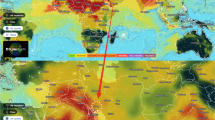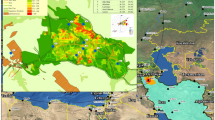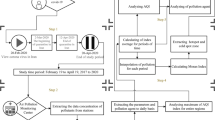Abstract
In response to the COVID-19 pandemic, the Iranian government swiftly implemented immediate and decisive measures to control the spread of the infection. This study aims to demonstrate the impact of restriction measure on air pollution, also to highlight the potential variability in results that can arias from different methodological approach. A comprehensive dual-approach assessment was conducted to evaluate the effect of the lockdown measures on criteria air pollutants. Firstly, a traditional approach compared air quality during the pandemic period with baseline conditions from 2013 to 2019. Secondly, observed air pollution values during different periods with varying restrictions in 2020 were compared with expected values. This comprehensive analysis allows for a robust comparison and quantification of the impact of different lockdown measures in Ahvaz. The study revealed significant changes in air pollutant concentrations in Ahvaz during 2020, with variations observed across different pollutants. Notable reductions were observed in O3 levels, particularly in November (-54.44% compared to the baseline) and December (-63.58% compared to expected values). Decreases in CO levels were observed in multiple months, while substantial reductions in PM10 and PM2.5 were observed during various periods. Inconsistencies in the magnitudes and directions of changes were found when comparing baseline and forecasted values. The overall stringency index showed an inverse association with changes in O3, NO2, and CO, with international travel controls and restrictions on internal movement having significant impacts. This study provides valuable insights into the impact of COVID-19 lockdown measures on air pollution in Ahvaz, Iran, using a comprehensive dual-approach assessment. The findings highlight the effectiveness of these measures in reducing specific criteria air pollutants and emphasize the importance of implementing appropriate strategies for air quality management during similar public health emergencies.







Similar content being viewed by others
Explore related subjects
Discover the latest articles and news from researchers in related subjects, suggested using machine learning.Data availability
The datasets generated during and/or analyzed during the current study are available from the corresponding author upon reasonable request.
References
Barbieri, D. M., Lou, B., Passavanti, M., Hui, C., Lessa, D. A., Maharaj, B., Banerjee, A., Wang, F., Chang, K., Naik, B., Yu, L., Liu, Z., Sikka, G., Tucker, A., Mirhosseini, A. F., Naseri, S., Qiao, Y., Gupta, A., Abbas, M., … Adomako, S. (2020). Survey data regarding perceived air quality in Australia, Brazil, China, Ghana, India, Iran, Italy, Norway, South Africa, United States before and during Covid-19 restrictions. Data in Brief, 32, 106169.
Bherwani, H., Kumar, S., Musugu, K., Nair, M., Gautam, S., Gupta, A., Ho, C. H., Anshul, A., & Kumar, R. (2021). Assessment and valuation of health impacts of fine particulate matter during COVID-19 lockdown: A comprehensive study of tropical and sub tropical countries. Environmental Science and Pollution Research International, 28, 44522–44537.
Box, G. E. P., Jenkins, G. M., Reinsel, G. C., & Ljung, G. M. (2015). Time Series Analysis: Forecasting and Control. Wiley.
Broomandi, P., Karaca, F., Nikfal, A., Jahanbakhshi, A., Tamjidi, M., & Kim, J. R. (2020). Impact of COVID-19 event on the air quality in Iran. Aerosol and Air Quality Research, 20, 1793–1804.
Chen, K., Wang, M., Huang, C., Kinney, P. L., & Anastas, P. T. (2020). Air pollution reduction and mortality benefit during the COVID-19 outbreak in China. Lancet Planet Health, 4, e210–e212.
Chen, X., Zhang, F., Zhang, D., Xu, L., Liu, R., Teng, X., Zhang, X., Wang, S., & Li, W. (2023). Variations of air pollutant response to COVID-19 lockdown in cities of the Tibetan Plateau. Environmental Science: Atmospheres, 3, 708–716.
Chereches, I. A., Arion, I. D., Muresan, I. C., & Gaspar, F. (2023). Study of the effects of the COVID-19 pandemic on air quality: A case study in Cluj-Napoca, Romania. Sustainability, 15, 2549.
Fei, S., Wagan, R. A., Hasnain, A., Hussain, A., Bhatti, U. A., & Elahi, E. (2022). Spatiotemporal impact of the COVID-19 pandemic lockdown on air quality pattern in Nanjing, China. Frontiers in Environmental Science, 10, 952310.
Filippini, T., Rothman, K. J., Goffi, A., Ferrari, F., Maffeis, G., Orsini, N., & Vinceti, M. (2020). Satellite-detected tropospheric nitrogen dioxide and spread of SARS-CoV-2 infection in Northern Italy. Science of the Total Environment, 739, 140278.
Gu, B., & Liu, J. (2023). COVID-19 pandemic, port congestion, and air quality: Evidence from China. Ocean & Coastal Management, 235, 106497.
Guo, Q., He, Z., & Wang, Z. (2023). Change in air quality during 2014–2021 in Jinan City in China and its influencing factors. Toxics, 11, 210.
Guo, Q., He, Z., & Wang, Z. (2024). The characteristics of air quality changes in Hohhot City in China and their relationship with meteorological and socio-economic factors. Aerosol and Air Quality Research, 24, 230274.
Hale, T., Angrist, N., Goldszmidt, R., Kira, B., Petherick, A., Phillips, T., Webster, S., Cameron-Blake, E., Hallas, L., Majumdar, S., & Tatlow, H. (2021). A global panel database of pandemic policies (Oxford COVID-19 Government Response Tracker). Nature Human Behaviour, 5, 529–538.
Hasnain, A., Sheng, Y., Hashmi, M. Z., Bhatti, U. A., Ahmed, Z., & Zha, Y. (2023). Assessing the ambient air quality patterns associated to the COVID-19 outbreak in the Yangtze River Delta: A random forest approach. Chemosphere, 314, 137638.
Kaydi, N., Maraghi, E., Shenavar, B., Bahrami, Z., Azarian, A., Rostami, S., Ashrafi, M. J., Karimi, S., Haghighifard, N. J. & Khafaie, M. A. (2024). Air pollution history and projection in Ahvaz: Insights from one of the most polluted cities in the world. Environmental Engineering and Management Journal. Forthcoming.
Li, K., Ni, R., Jiang, T., Tian, Y., Zhang, X., Li, C., & Xie, C. (2022). The regional impact of the COVID-19 lockdown on the air quality in Ji’nan, China. Scientific Reports, 12, 12099.
Mazlan, N. A., Zaki, N. A. M., Narashid, R. H., Talib, N., Manokaran, J., Arshad, F. C., Fauzi, S. S. M., Dom, N. C., Valipour, M., & Dambul, R. (2023). COVID-19 restriction movement control order (MCO) impacted emissions of peninsular Malaysia using Sentinel-2a and Sentinel-5p satellite. Earth Systems and Environment, 7, 347–358.
Sharma, P., Ghosh, A., & Patra, P. (2023). Statistical assessment of COVID-19 lockdowns on ambient air quality, Himachal Pradesh and learnings for implementing clean technologies: Insight from industrial town, India. Management of Environmental Quality: An International Journal, 34, 386–407.
Sicard, P., de Marco, A., Agathokleous, E., Feng, Z., Xu, X., Paoletti, E., Rodriguez, J. J. D., & Calatayud, V. (2020). Amplified ozone pollution in cities during the COVID-19 lockdown. Science of the Total Environment, 735, 139542.
Tobías, A., Carnerero, C., Reche, C., Massagué, J., Via, M., Minguillón, M. C., Alastuey, A., & Querol, X. (2020). Changes in air quality during the lockdown in Barcelona (Spain) one month into the SARS-CoV-2 epidemic. Science of the Total Environment, 726, 138540.
Venter, Z. S., Aunan, K., Chowdhury, S., & Lelieveld, J. (2020). COVID-19 lockdowns cause global air pollution declines. Proceedings of the National Academy of Sciences, 117, 18984–18990.
Volke, M. I., Abarca-Del-rio, R., & Ulloa-Tesser, C. (2023). Impact of mobility restrictions on NO2 concentrations in key Latin American cities during the first wave of the COVID-19 pandemic. Urban Climate, 48, 101412.
Acknowledgements
The study was approved by Ahvaz Jundishapur University of Medical Sciences. Air pollutants and meteorological data were provided by the Khuzestan Environmental Department, (Ahvaz Office)
Funding
The study is supported by a grant from Student Research Committee, Ahvaz Jundishapur University of Medical Sciences, Ahvaz, Iran.
Author information
Authors and Affiliations
Contributions
Neda Kaydi.: Writing—Original Draft and Project administration Morteza Abdullatif Khafaie: Conceptualization, Methodology, Writing—Review & Editing and Funding acquisition Neemat Jaafarzadeh: Conceptualization, Methodology, and Supervision, Elham Maraghi: Data Curation and Formal analysis, Bamshad Shenavar.: Resources and Visualization, Zeinab Bahrami.: Writing—Review & Editing, Alireza Azarian.: Resources, Soghra Rostami.: Resources, interpretation of data. Mehdi Mojadam.: Resources, Validation, Faezeh Jahedi.: Resources, interpretation of data. All authors read and approved the final manuscript.
Corresponding authors
Ethics declarations
Ethical approval
The study received ethical approval from Ahvaz Jundishapur University of Medical Sciences (IR.AJUMS.REC.1402.328).
Consent to participate
Not applicable.
Consent to publish
Not applicable.
Competing interests
The authors declare no competing interests.
Additional information
Publisher's Note
Springer Nature remains neutral with regard to jurisdictional claims in published maps and institutional affiliations.
Rights and permissions
Springer Nature or its licensor (e.g. a society or other partner) holds exclusive rights to this article under a publishing agreement with the author(s) or other rightsholder(s); author self-archiving of the accepted manuscript version of this article is solely governed by the terms of such publishing agreement and applicable law.
About this article
Cite this article
Kaydi, N., Maraghi, E., Bahrami, Z. et al. Quantifying the impact of COVID-19 restrictions on air pollution in Ahvaz: a comparative dual-approach assessment of observed against baseline and forecasted criteria air pollutants. Environ Monit Assess 196, 1079 (2024). https://doi.org/10.1007/s10661-024-13231-8
Received:
Accepted:
Published:
DOI: https://doi.org/10.1007/s10661-024-13231-8




